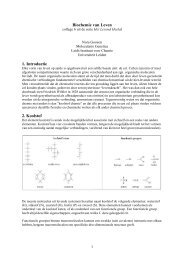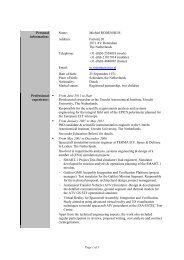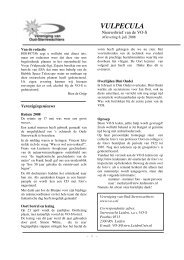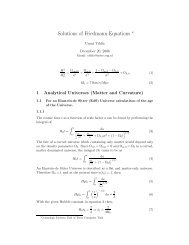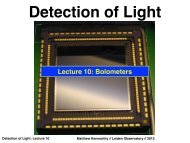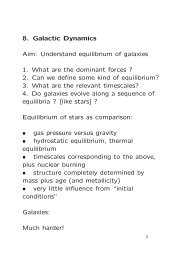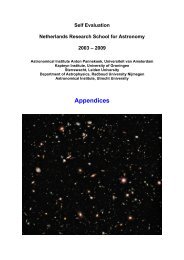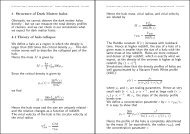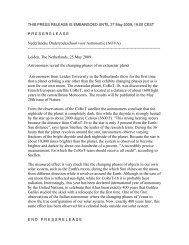cheops - Leiden Observatory
cheops - Leiden Observatory
cheops - Leiden Observatory
Create successful ePaper yourself
Turn your PDF publications into a flip-book with our unique Google optimized e-Paper software.
An S‐class mission<br />
New class: XLC mission ≤ 50 M€<br />
René Liseau - Onsala Space <strong>Observatory</strong> - Sweden
An S‐class mission<br />
with<br />
launch 2017
it all began – in Sweden… an SNSB 2011 initiative<br />
1.<br />
2.<br />
3.<br />
4.<br />
5.<br />
PressPressmeddelanden<br />
Fem innovativa satellitförslag går till final<br />
I höstas efterlyste Rymdstyrelsen förslag på nya innovativa svenska satellitprojekt till låg kostnad, under 40 miljoner kronor. Nu har fem av<br />
inlämnade förslagen valts ut och går vidare till tekniska förstudier.<br />
Totalt skickades tolv förslag från flera olika forskningsområden in till Rymdstyrelsen. Efter<br />
utvärdering av en internationell expertgrupp har Rymdstyrelsen idag beslutat att fem av<br />
förslagen får gå vidare till teknisk utvärdering. Ett mål för Rymdstyrelsens utlysning är att<br />
ytterligare stimulera nya idéer inom rymdteknik och forskning t.ex. miniatyrisering och<br />
kostnadseffektiva byggnadssätt.<br />
– Vi vill visa att den typ av ny teknik som Rymdstyrelsen stöttat kan användas för att förändra<br />
sättet man bygger rymdprojekt på och visa att det går att leverera utmärkta forskningsresultat<br />
för mycket mindre pengar, säger Johan Köhler, forskningshandläggare och ansvarig för<br />
projektet vid Rymdstyrelsen.<br />
Följande förslag har av Rymdstyrelsen tagit ut till final:<br />
CHEOPS – (CHaracterizing ExOPlanet Satellite) mäter egenskaper hos planeter runt andra<br />
stjärnor. Ansvarig: René Liseau, Chalmers.<br />
Alfvén – (Explorer of small scale structure in the aurora) utforskar av fina detaljer i norrsken.<br />
Ansvarig: Hans Nilsson, IRF, Kiruna.<br />
METAL – (Microspacecraft interplanetary mission to a magnetized metallic M-class<br />
asteroid) besöker för första gången en metallisk asteroid. Ansvarig: Jan-Erik Wahlund, IRF,<br />
Uppsala.<br />
Tor – studerar växelverkan mellan solvind och jordens magnetosfär bl.a. turbulenta<br />
fenomen. Ansvarig: Andris Vaivads, IRF, Uppsala.<br />
MATS – (Mesospheric waves from airglow transient signatures) studerar vågrörelser i högre<br />
atmosfärslager som mäts in från ljussken alstrade på dessa höjder. Ansvarig: Jörg Gumbel,<br />
MISU.<br />
Nästa steg i processen är att Rymdstyrelsen låter svensk industri utföra tekniska förstudier av
Content 59 Biesbroek, Robin<br />
robin.biesbroek esa.int<br />
ESA<br />
S-LUNA<br />
11-October-2012 10:06:36<br />
S-class mission Letters of Intent<br />
61 Tavani, Marco<br />
GAMMA-LIGHT<br />
pi.agile iasf-roma.inaf.it<br />
In response to the "Call for a Small mission opportunity in ESA's Science Programme for<br />
INAF<br />
a launch in 2017", issued on 9 March 2012, the following Letters of Intent (LOI) have<br />
been 62 received:<br />
Foing, Bernard<br />
SMART+<br />
b.h.foing vu.nl<br />
Ref. Contact Vrije Universiteit name, Amsterdam & ESTEC Title of LOI<br />
65<br />
Email,<br />
Anagnostopoulos, Georgios<br />
Institution<br />
ganagno ee.duth.gr<br />
Validation of the Lithosphere-Atmosphere-<br />
Ionosphere-Magnetosphere Coupling Concept<br />
2 Sutton, Demokritos James University of Thrace<br />
ESA Associated Small Mission with great Letter (M>4.5) of Intent Earthquakes - by<br />
jrfsutton virginmedia.com<br />
Immunogenetics<br />
using low orbit satellite observations<br />
66<br />
Sutton<br />
Drinis, John<br />
ESA S-Class Mission<br />
5 Khalesi, ydrinis algosystems.gr<br />
Mandali<br />
mandali Algosystems uchusencompany.com<br />
MAGES - Magnetospheric Earth Swarm<br />
68<br />
Uchusen Company Ltd<br />
Rigatos, Gerasimos<br />
ESA S-Class Mission<br />
6 Rudawy, grigat isi.gr Pawel<br />
Advanced Solar-Terrestrial European X-ray<br />
rudawy Industrial astro.uni.wroc.pl<br />
Systems Institute<br />
spectrophotometer: ASTEX<br />
69<br />
Space Research Centre Polish Academy of<br />
Bombardelli, Claudio<br />
Sciences<br />
claudio.bombardelli upm.es<br />
S-class mission to a nearby asteroid<br />
7 Jansen, Technical Frank University of Madrid<br />
SmallCostSat<br />
70<br />
frank.jansen dlr.de<br />
Ursin, Rupert<br />
DLR Institute of Space Systems<br />
rupert.ursin univie.ac.at<br />
Space-QUEST<br />
8 De IQOQI Ridder, Joris<br />
PlanetVision: Characterizing Planetary Systems<br />
71<br />
joris ster.kuleuven.ac.be<br />
Malbet, Fabien<br />
KU Leuven<br />
Fabien.Malbet obs.ujf-grenoble.fr<br />
micro-NEAT: a high precision astrometry mission<br />
to identify the high-mass planets around nearby<br />
9 Baan, IPAG Willem<br />
SURO-LC: stars The Space Based Ultra-Long<br />
72<br />
baan astron.nl<br />
Sarris, Theodoros<br />
Netherlands Institute for Radio<br />
tsarris athena-spu.gr<br />
Astronomy<br />
ATHENA-SPU<br />
Wavelength Radio <strong>Observatory</strong><br />
Low-Flying Spacecraft 'Daedalus'<br />
73 Ciufolini, Lgnazio<br />
ignazio.ciufolini unisalento.it<br />
Università del Salento<br />
74 Baratoux, David<br />
david.baratoux irap.omp.eu<br />
Université de Toulouse, UPS-OMP, IRAP<br />
Testing General Relativity with laser ranged<br />
satellites<br />
Space-based observatory for optical monitoring<br />
of meteoroids colliding with the Earth<br />
74 LoIs 43 proposals & CHEOPS made it to
implemented for the first small mission opportunity in 2017 (“S1”).<br />
the top ten selected by the advisory bodies<br />
The 10 proposals that were submitted to the Advisory Structure for the evaluation were:<br />
1. AXIOM-C (X-ray imaging of the magnetosphere – cusps)<br />
2. CHEOPS (Exo-planetary transits)<br />
3. LARES-2 (Fundamental physics and general relativity testing)<br />
4. MASE (Magnetic activity of stars and exoplanets)<br />
5. NITRO (Composition measurement in the inner magnetosphere and auroral region)<br />
6. PlaVi (Exo-planetary transits and asteroseismology)<br />
7. SIRIUS (Ultraviolet spectroscopy of stars and insterstellar medium)<br />
8. TOR (Energy dissipation in solar wind turbulence)<br />
9. SIGMA (Measurements of the solar corona magnetic field)<br />
10. XIPE (X-ray imaging polarimetry)<br />
At their extraordinary meeting shown on here September in alphabetical 20 the SSAC, order<br />
having carefully considered t<br />
advice received from the Working Groups, unanimously recommended the CHEOPS missi<br />
proposal for implementation as the first Small Mission, S1.<br />
Following the advice of the SSAC, the Director of Science and Robotic Exploration<br />
herewith proposing to select the CHEOPS mission as the first Small Mission for launch<br />
2017. Should the SPC approve the proposal, the Executive intends to immediately start t
implemented for the first small mission opportunity in 2017 (“S1”).<br />
the top ten selected by the advisory bodies<br />
The 10 proposals that were submitted to the Advisory Structure for the evaluation were:<br />
1. AXIOM-C (X-ray imaging of the magnetosphere – cusps)<br />
2. CHEOPS (Exo-planetary transits)<br />
3. LARES-2 (Fundamental physics and general relativity testing)<br />
4. MASE (Magnetic activity of stars and exoplanets)<br />
5. NITRO (Composition measurement in the inner magnetosphere and auroral region)<br />
6. PlaVi (Exo-planetary transits and asteroseismology)<br />
7. SIRIUS (Ultraviolet spectroscopy of stars and insterstellar medium)<br />
8. TOR (Energy dissipation in solar wind turbulence)<br />
9. SIGMA (Measurements of the solar corona magnetic field)<br />
10. XIPE (X-ray imaging polarimetry)<br />
At their extraordinary meeting on September 20 the SSAC, having carefully considered t<br />
advice October received 19, from 2013 the Working Groups, unanimously recommended the CHEOPS missi<br />
proposal for implementation as the first Small Mission, S1.<br />
SPC decision for S1 =<br />
Selected as No. 1<br />
Following the advice of the SSAC, the Director of Science and Robotic Exploration<br />
herewith proposing to select the CHEOPS mission as the first Small Mission for launch<br />
2017. Should the SPC approve the proposal, the Executive intends to immediately start t
implemented for the first small mission opportunity in 2017 (“S1”).<br />
The 10 proposals that were submitted to the Advisory Structure for the evaluation were:<br />
1. AXIOM-C (X-ray imaging of the magnetosphere – cusps)<br />
2. CHEOPS (Exo-planetary transits)<br />
3. LARES-2 (Fundamental physics and general relativity testing)<br />
4. MASE (Magnetic activity of stars and exoplanets)<br />
5. NITRO (Composition measurement in the inner magnetosphere and auroral region)<br />
6. PlaVi (Exo-planetary transits and asteroseismology)<br />
7. SIRIUS (Ultraviolet spectroscopy of stars and insterstellar medium)<br />
8. TOR (Energy dissipation in solar wind turbulence)<br />
9. SIGMA (Measurements of the solar corona magnetic field)<br />
10. XIPE (X-ray imaging polarimetry)<br />
At their extraordinary meeting on September 20 the SSAC, having carefully considered t<br />
advice October received 19, from 2013 the Working Groups, unanimously recommended the CHEOPS missi<br />
proposal for implementation as the first Small Mission, S1.<br />
SPC decision for S1 = CHEOPS<br />
Following the advice of the SSAC, the Director of Science and Robotic Exploration<br />
herewith proposing to select the CHEOPS mission as the first Small Mission for launch<br />
h#p://www.esa.int/esaCP/SEMXFG4S18H_index_0.html<br />
2017. Should the SPC approve the proposal, the Executive intends to immediately start t
Austria<br />
Belgium<br />
Switzerland<br />
France<br />
Italy<br />
Sweden<br />
United Kingdom<br />
CHaracterizingExOPlanet Satellite Proposal #12 for ESA S-Mission Call<br />
!"#$%&$'()$%*+,'<br />
Confoederatio Helvetica – led mission…<br />
Mission Coordinator:<br />
Prof. Willy Benz<br />
Physics Institute<br />
Center for Space and Habitability<br />
Sidlertrasse 5<br />
3012 Bern<br />
Switzerland<br />
e-mail: willy.benz@space.unibe.ch<br />
Proposing Team Members:<br />
Mission Project Manager:<br />
Dr. Christopher Broeg<br />
Physics Institute<br />
Center for Space and Habitability<br />
Sidlerstrasse 5<br />
3012 Bern<br />
Switzerland<br />
e-mail: christopher.broeg@space.unibe.ch<br />
Country Institute Short Name<br />
A Institut für Weltraumforschung, Graz, Austria IWF Wolfgang Baumjohann<br />
B Centre Spatial de Liège CSL Etienne Renotte<br />
B University of Liège ULg Michaël Gillion<br />
CH Swiss Space Center SSC-EPFL Anton Ivanov<br />
CH ETH Zürich ETHZ Michael Meyer<br />
CH Universität Bern UBE Nicolas Thomas<br />
CH <strong>Observatory</strong> of the University of Geneva UGE Didier Queloz<br />
F Laboratoire d'astrophysique de Marseille LAM Magali Deleuil<br />
I Osservatorio Astronomico di Padova - INAF INAF-OAPD Roberto Ragazzoni<br />
I Osservatorio Astrofisico di Catania – INAF INAF-OACT Isabella Pagano<br />
I Università di Padova UPD Giampaolo Piotto<br />
S Onsala Space <strong>Observatory</strong>, Chalmers Univ. of OSO Rene Liseau<br />
Technology<br />
S Stockholm University, Stockholm UST Göran Oloffson<br />
UK University of Warwick UWW Don Pollacco<br />
Associated Scientists and Engineers:<br />
Austria: Manuel Güdel (UniW), Helmut Lammer (IWF), Manfred Steller (IWF),<br />
Belgium: Brice-Olivier Demory (MIT/ULg)<br />
France: François Bouchy (IAP/OHP), Guillaume Hébrard (IAP/OHP), Patrick Levacher (LAM),<br />
Claire Moutou (LAM),<br />
Italy: Demetrio Magrin (INAF-OAPD), Jacopo Farinato (INAF-OAPD), Antonino F. Lanza (INAF-<br />
OACT), Giuseppina Micela (INAF-OAPA), Emilio Molinari (INAF-FGG), Valerio Nascimbeni<br />
(UPD), Salvatore Scuderi (INAF-OACT), Alessandro Sozzetti (INAF-OATO)<br />
Sweden: Alexis Brandeker (UST), David Hobbs, Anders Johansen (both Lund <strong>Observatory</strong>), Kay<br />
Justtanont (OSO)<br />
Switzerland: Yann Alibert (UBE), Roi Alonso (IAC Spain), Mathias Beck (UGE), Federico Belloni<br />
(SSC-EPFL), Bruno Chazelas (UGE), Piers Christiansen (UBE), Andrea Fortier (UBE), Kevin Heng<br />
(ETHZ), Luzius Kronig (SSC-EPFL), Daniele Piazza (UBE), Sasha Quanz (ETHZ), Udo Wehmeier<br />
(ETHZ), Francois Wildi (UGE),<br />
United Kingdom: Andrew Cameron (St-Andrew UK)
So, what is CHEOPS ?
Winn 2009
elies completely<br />
on components<br />
with flight heritage
Targets: known to harbour planets<br />
nearby bright stars<br />
spectroscopy e.g. JWST, ECHO<br />
known ephemerids<br />
O 2 C residuals (m s ) 1.20<br />
Reduced x 2 value 1.51<br />
BJD, barycentric Julian date; O 2 C, observed minus calculated.<br />
Fig. 4b we show that the 3.236-d signal conserves its phase for each<br />
observational year, which is expected for a planetary signal.<br />
An important piece of information about the inner composition of<br />
an exoplanet is obtained when the planet is transiting its parent star,<br />
allowing its radius to be measured. Combined with the real mass<br />
estimate, the radius leads to the average density of the planet. In the<br />
present case, given a stellar radius 36 of 0.863 times the solar radius and<br />
assuming the radius of the planet is that of the Earth, the planet transit<br />
probability is estimated at 10%, with a transit depth of 10 24 . The<br />
known distance (π HIPPARCOS/GAIA)<br />
a Centauri B.<br />
known radius/mass (θ VLT-I/a-seismology)<br />
known spectrum (Teff , [Fe/H], log g)<br />
detection of a planet transit, only possible from space, would allow<br />
us to confirm the expected rocky nature of the detected planet around<br />
The r.m.s. radial velocity induced by the stellar rotational activity<br />
amounts to 1.5 m s 21 on average. The detection of the tiny planetary<br />
signal, with a semi-amplitude K 5 0.51 m s 21 , thus demonstrates that<br />
stellar activity is not necessarily a definitive limitation to the detection<br />
of small-mass planets. Using an optimized observational strategy and<br />
the present knowledge about activity-induced radial-velocity effects,<br />
it is possible to model precisely and mitigate activity signals, and<br />
therefore improve considerably the planet detection limits.<br />
With a separation from its parent star of only 0.04 AU, the planet is<br />
orbiting very close to a Centauri B compared to the location of the<br />
habitable zone. However, the observed radial-velocity semi-amplitude<br />
is equivalent to that induced by a planet of minimum mass four<br />
times that of Earth in the habitable zone of the star (P 5 200 d; ref. 37).<br />
RV (m s –1 )<br />
2.0<br />
1.5<br />
1.0<br />
0.5<br />
0.0<br />
–0.5<br />
–1.0<br />
–1.5<br />
–2.0<br />
0.0 0.2 0.4 0.6 0.8 1.0<br />
Phase<br />
Figure 5 | Phase-folded radial-velocity curve with a period of 3.2357 d.<br />
Green dots, radial a = 9 Rvelocities B<br />
after correction of the stellar, binary and<br />
coordinates effects. Red dots, the same radial velocities binned in phase, with a<br />
niqu<br />
tim<br />
Rec<br />
tion<br />
sho<br />
the<br />
Rece<br />
Pub<br />
1.<br />
2.<br />
3.<br />
4.<br />
5.<br />
6.<br />
7.<br />
8.<br />
9.<br />
10.<br />
11.<br />
12.<br />
13.<br />
14.<br />
15.<br />
16.<br />
17.<br />
18.<br />
19.<br />
20.<br />
21.<br />
22.<br />
23.
,)&()0'/+&1)<br />
ence of the event, and the detailed shape of the transit light curve<br />
e eclipse and the ratio of the planetary radius to that of the star, (2) the<br />
ensity of the star<br />
law from the<br />
transit). These<br />
the effective<br />
osphere and an<br />
rieving the mass<br />
and finally the<br />
he planet. (Mazeh<br />
The precision of<br />
directly affected<br />
stellar parameters<br />
ht curve during a<br />
eraged over the<br />
the transit signalof<br />
a hot Neptune,<br />
y 3 hours, for a<br />
urs. In both cases<br />
10 is required to<br />
ee Fig. 5) and<br />
ius of the planet<br />
CHEOPS goes for small planets: transit of Earth‐size planet<br />
Figure 5: Simulation of a transiting Earth size-sized<br />
planet of 60 day period orbiting a G5 star of 8th Vmagnitude<br />
as observed by CHEOPS. Sampling time is<br />
1 minute and photon noise 100 ppm/minute. The red<br />
dots indicate 1h-averaged photometry. This light curve<br />
illustrates a transit detection with a S/Ntransit=10.<br />
80 ppm<br />
t G2V ≤ 0.5 days
surements of their mass and radius, but also a study of their atmospheric properties.<br />
ossible for planets orbiting bright enough stars to permit high signal-to-noise<br />
ric observations. This<br />
is drastically more<br />
-mass planets than for<br />
ng to the conclusion<br />
ew dozens of supertistically<br />
transit the<br />
within the solar<br />
will ever be suitable<br />
characterization with<br />
ts (e.g. Seager et al.<br />
has been nicely<br />
the case of the planet<br />
s eight Earth-masses<br />
y one transiting a star<br />
ed eye. First detected<br />
easurements, transits<br />
ed by the Spitzer and<br />
lescopes (Demory et<br />
t al. 2011), revealing<br />
size of ~2.1 Earththe<br />
brightness of its Figure 1: Mass-radius relationship for different bulk composition of<br />
, K=4), very high the planet (Adapted from Wagner et al. 2011) with superimposed<br />
ccultation photometry<br />
th Spitzer, leading to<br />
the thermal emission<br />
rth planet (Demory et<br />
known transiting planets where both the mass and the radius of the<br />
planet have been measured. The size of the boxes indicates the 1sigma<br />
error on these parameters. So far, in most cases the error bars<br />
are too large to obtain an unambiguous measurement of the bulk<br />
structure of the planets.<br />
Primary Objec-ve: measure mass‐radius relaRon for low‐mass planets…
le light sources in the universe. Time will be made available for this<br />
1'&<br />
d the large error<br />
tion for planets<br />
n to 1 MEarth is<br />
PS will provide a<br />
by significantly<br />
ize as well as the<br />
ts. We anticipate<br />
gnificant intrinsic<br />
relationship. This<br />
ich diversity of<br />
formation and<br />
ms, and thus can<br />
odels of these<br />
io, the core of a<br />
mass before it is<br />
ay fashion. This<br />
many physical<br />
portant of which<br />
cretion.<br />
mean planetary<br />
… to determine the bulk structure of planets<br />
0% (10 -4 %)<br />
Figure 2: Radius of a hot rocky planet surrounded by a<br />
water atmosphere. The composition of the planetary core<br />
is similar to the one of the Earth, and the mass of the<br />
water envelope is indicated on the figure (in percentage<br />
of the total planetary mass). Adapted from Valencia et<br />
al. (2010).
Figure 12: Initial mechanical concept for the telescope and the lightweighted primary mirror.<br />
elevate and stabilize the temperature. A further key iss<br />
to be the shrinkage by CFRP due to moisture release<br />
Table 7: Current payload mass breakdown<br />
The mechanical concept is shown in Fig. 12. The preliminary mass breakdown is shown in Table 7.<br />
The structure is to be manufactured out of 33.5 a carbon-fibre cm (F/8) reinforced CFRP polymer (≥50%) structure (CFRP; heritage 5*9#0!%,-/01!EK8!<br />
from RUAG Space Switzerland) with Zerodur reflective Zerodur mirrors + with Ag protected silver coatings /*G7*-6-9$.! !<br />
K#L,#9*+! ;13! ;12!<br />
@:96+!A#QQ06!F$$6GH0I! ;;13! ;C12!<br />
5*9#0!
platforms would be capable of delivering the necessary performance.<br />
!"2 3456/*4+40'1,<br />
!"2"7 89:,*456/*4+40'1,16++&*;,<br />
The key requirements for the spacecraft can be traced<br />
to the photometric performance required by the<br />
CHEOPS mission:<br />
AOCS / Pointing stability: AOCS shall provide 8arcsec<br />
stability rms (or better) over 10 hour<br />
observations. The S/C shall be 3-axis stabilized but<br />
nadir locked.<br />
expertise for addressing the AOCS design during the Phase A and identifying the modifications to the<br />
Thermal stability: Thermal SSTL-150 standard interface equipment between necessary to meet the pointing requirements is present in Italy. For<br />
spacecraft bus and detector instance, assembly Thales Alenia shall Space be Italy stable recently performed as Prime Contractor the Definition Phase of<br />
Figure 12: Initial mechanical concept for the telescope and the lightweighted PLATO, a mission primary with mirror. similar scientific objectives, having in particular the responsibility of the<br />
(!T=1K, TBC) and provide whole a AOCS location architecture for the (including payload the interface with the payload telescopes), operational modes<br />
The mechanical concept is shown in Fig. radiator 12. The so preliminary that the radiator mass design, breakdown always sensors/actuators faces is identification, cold shown space in Table performance 7. analysis, simulation and budgets. This capability<br />
(no flux from Earth or Sun). also exists in Sweden.<br />
The structure is to be manufactured out of 33.5 a carbon-fibre cm (F/8) reinforced CFRP polymer (≥50%) structure (CFRP; heritage<br />
The orbit control system consists of a xenon-based resistojet propulsion system with a total delta-v<br />
from RUAG Space Switzerland) with Power: Zerodur The reflective spacecraft Zerodur mirrors shall capability provide + with Ag of 36 protected 54W m/s. The continuous gaseous silver nature coatings of the xenon propellant avoids issues associated with<br />
(heritage e.g. SESO, Selex Galileo). The power primary for will instrument be lightweighted operations propellant to slosh, at least and is thus 50% appropriate. to reduce Although total a low level of orbit maintenance propellant may be<br />
required to maintain altitude during the operational phase of the mission, the majority of this<br />
mass. The telescope must be baffled to Data: reduce The stray spacecraft light (primarily shall provide from the at least Earth). 1GBit/day Concerns over<br />
propulsion capability is likely to be used to lower the orbit at the end of life, hence ensuring<br />
cleanliness and contamination lead to introduction downlink of a door cover compliance (which with is light debris and mitigation dust standards. tight). It An is estimated delta-v of
Fourtney et al.<br />
2008<br />
onto the primary mirror is the largest source of<br />
Figure 10: PSF of the preliminary optical design.<br />
stray light in the current baffle design. By<br />
increasing the length of the baffle, both scattering from the spider and scattering from the baffle to the<br />
secondary mirror are minimised. Combined with an inner and outer baffling system (cf. CoRoT) the<br />
major stray light requirement (reaching < 1 ph/px/s) can be met. A comparison of the point source<br />
transmission functions of CoRoT, the Cassini orbiter narrow angle camera, and our preliminary design<br />
is made in Fig. 11. At this stage, black coatings with 2% hemispherical (isotropic) reflectivity may be<br />
straylight main noise culprit<br />
single frame-transfer !T !10 mK<br />
back-side illuminated @<br />
CCD 0.4-1.1 µm<br />
T < 233 K<br />
The 13 μm pixel 1k x 1k CCD<br />
(baseline = e2v CCD47‐20 AIMO)<br />
is used with a mid‐band coaRng to enhance the<br />
quantum efficiency.<br />
Replace the CCD detector w.<br />
Hawaii-2RG<br />
Beam splitter will provide two<br />
images on the same detector<br />
0.4–1.05 µm and 1.05–1.7 µm<br />
required together with knife-edge radii of the baffle vanes of 100 µm. The stray light distribution and<br />
its variability on the focal plane have been simulated to evaluate whether the correction requirement<br />
can be met. Preliminary results<br />
Table 4: Working error budget for the CHEOPS Instrument<br />
System.<br />
Quantity Bright Intermed.<br />
Faint Very<br />
faint<br />
Magnitude (G type star) 8 10 12 12.5<br />
Texp per image [s] 10 10 10 10<br />
%age FW 26% 4.1% 0.65% 0.41%<br />
Shot-noise [ppm] 224.7 563.3 1418.1 1785.6<br />
Read noise [ppm] 14.6 92.4 582.9 924.0<br />
Quantize noise [ppm] 3.6 22.7 144.0 228.3<br />
Flat-field (FF) 4 [ppm] 14.8 14.8 14.8 14.8<br />
Zodiacal light, dark noise<br />
post-subtraction 1 [ppm]<br />
17.7 112.45 709.3 1124.5<br />
Gain stability [ppm] 5.0 5.0 5.0 5.0<br />
QE stability [ppm] 5.0 5.0 5.0 5.0<br />
Dark current var. [ppm] 0 0 0 0<br />
Resid. elec. noise [ppm] 0 1.6 10.1 15.9<br />
Timing error [ppm] 2 2 2 2<br />
Stray light 2 [ppm] 1.8 11.3 71.5 114.0<br />
Cosmic ray 3 [ppm] 1.3 1.3 1.3 1.3<br />
Total S/N single image<br />
[ppm]<br />
225.4 573.1 1542.0 2027.0<br />
Total S/N 1 min [ppm] 101.0 256.6 692.7 912.4<br />
Total S/N 1 h on target<br />
[ppm]<br />
Total S/N 3 h on target<br />
[ppm]<br />
14.3 33.7 110.4 158.6<br />
10.4 22.5 87.3 131.3<br />
1 We assume zodiacal light at the level determined by WFC3, which<br />
can be subtracted perfectly. 2 Assuming 99.6% correction of a level<br />
set 1.1 e/s/px (comparable to COROT) 3 Cosmic ray flux taken from<br />
WFC3 and modified for this detector. 4 The flat-field error relates to<br />
the 8 arcsec jitter requirement combined with an assumed<br />
knowledge accuracy on the FF. White coloured boxes = input stellar<br />
fluxes; Green = Gaussian noises; Yellow = design and calibrated;<br />
Red = post-factum calibration; White (below) = total accuracy<br />
indicate that stray the light correction<br />
will be sufficient for the targeted<br />
photometric accuracy.<br />
The S/N budget (see Table 4) also<br />
reveals the importance of thermal<br />
stability of the CCD and proximity<br />
electronics (including the gain).<br />
Based upon similar devices (e.g. the<br />
e2v detector currently flying on<br />
Rosetta/OSIRIS), the CCD needs to<br />
be held at constant temperature to an<br />
accuracy of ~10 mK for the duration<br />
of one observation, to limit its noise<br />
contribution to ~5 ppm. The detector<br />
is connected to an external radiator,<br />
which will give an operating<br />
temperature of
We anticipate 6 planets of that kind will be detected by NGTS on stars brighter than V < 12<br />
magnitude. Note that the NGTS targeting scenario is flexible enough to be optimized to CHEOPS<br />
Target Selection<br />
pointing capabilities.<br />
Table 2: Expected number of transiting planets to be detected by NGTS after 5 years of observation in<br />
different stellar magnitude and planet radius bins. This corresponds to a survey of 10% of the southern<br />
sky. The color of the box indicates the estimated CHEOPS capabilities to successfully observe these<br />
objects (Green box: Light curve measured by CHEOPS with S/Ntransit achievable with CHEOPS and methods<br />
required: Green – S/Ntransit > 30; Light Green: S/Ntransit > 30 achievable but requires 4 to 10 transits to be co-added;<br />
Yellow - detectable but S/Ntransit only > 10.<br />
Radius: R
Figure 4: Transiting planets from different surveys: Planet radius vs. V-magnitude of the host star.<br />
Pink diamond: ground based transiting planet (mostly WASP and HAT), Green: radial velocity survey<br />
planets that have been found transiting their star; Blue triangles: CoRoT transiting planets, Violet<br />
square: Kepler transiting planet candidates (only a handful have been confirmed). The orange area<br />
indicates the search domain of NGTS, the next generation ground transit search. The green area<br />
indicates the search area of the precise Doppler search programs like HARPS. This instrument will<br />
provide measurements of planet masses to 20% accuracy for objects lying to the right of the black<br />
solid line (assuming the period and ephemerids are known and 20 measurements are available)<br />
provided they have an Earth-like mean density. The dotted black line gives the limit for a mean density<br />
corresponding to water-ice planets. The solid red curve indicates the CHEOPS limits for S/Ntransit=10<br />
and the dotted red indicates the CHEOPS limit for S/Ntransit=30.
Figure 7: Mollweide projection of the accessible celestial sphere for CHEOPS observations in the<br />
ICRF. It shows the total length of time (in hours) a given area of the celestial sphere can be observed<br />
over a one year period from the SSO 6am/6pm at 800km orbit. Observation time-spans of shorter than<br />
60 mins have not been taken into account. Constraints taken into account are obscuration of the target<br />
by Earth, relative sun angle and restrictions on reflected sun light from Earth.<br />
15<br />
800 km Solar Synchronous Orbit 6:00/18:00<br />
near day-night terminator
While this orbit satisfies the main requirements, other orbits would provide even better solutions. For<br />
example, the option called “GTO extended” would allow a larger fraction of the sky to be seen albeit<br />
at the cost of increased technical effort and budget, see Table 3.<br />
In either case, the launch will be a shared launch: CHEOPS will not utilize the full capacity of a<br />
Figure VEGA 7: class Mollweide launch vehicle. projection The of baseline the accessible mission duration celestial is sphere 3.5 years for nominal CHEOPS mission. observations in the<br />
ICRF. It shows the total length of time (in hours) a given area of the celestial sphere can be observed<br />
!"# $%&'()<br />
over a one year period from the SSO 6am/6pm at 800km orbit. Observation time-spans of shorter than<br />
60 We mins performed have not a trade been taken off study into for account. different Constraints orbit types taken (SSO, into GTO, account Molniya are obscuration and L2). We of the compared target<br />
by the Earth, following relative parameters: sun angle and Observable restrictions sky, on radiation, reflected sun eclipses, light from telecommunication, Earth. cost, thermal<br />
environment and needed propulsion. The main driver, which determines the orbits available, is to meet 15<br />
the minimum required fraction of observable sky within the budgetary envelope available.<br />
Table 3: Orbit characteristics for the baseline and two options. *For the GTO extended, all targets can be<br />
observed at least 6 hours uninterrupted during the 3.5 year mission.<br />
Orbit characteristics SSO 800<br />
(baseline)<br />
SSO<br />
1200<br />
GTO<br />
extended<br />
Perigee altitude [km] 800 1200 10000<br />
Apogee altitude [km] 800 1200 35943<br />
Orbital period [min] 101 109 834<br />
Mean local time of ascending node [h] 6 a.m. 6 a.m. -<br />
Percentage of the sky available for a minimum total duration of 15 days<br />
27% 47% *<br />
per year and target. Maximum interruption time is 20 minutes per orbit.<br />
Percentage of the sky available for a minimum total duration of 60 days<br />
per year and target. Maximum interruption time is 50 minutes per orbit<br />
(for SSO).<br />
58% 69% 100%<br />
baseline
α Cen<br />
While this orbit satisfies the main requirements, other orbits would provide even better solutions. For<br />
example, the option called “GTO extended” would allow a larger fraction of the sky to be seen albeit<br />
at the cost of increased technical effort and budget, see Table 3.<br />
In either case, the launch will be a shared launch: CHEOPS will not utilize the full capacity of a<br />
Figure VEGA 7: class Mollweide launch vehicle. projection The of baseline the accessible mission duration celestial is sphere 3.5 years for nominal CHEOPS mission. observations in the<br />
ICRF. It shows the total length of time (in hours) a given area of the celestial sphere can be observed<br />
!"# $%&'()<br />
over a one year period from the SSO 6am/6pm at 800km orbit. Observation time-spans of shorter than<br />
60 We mins performed have not a trade been taken off study into for account. different Constraints orbit types taken (SSO, into GTO, account Molniya are obscuration and L2). We of the compared target<br />
by the Earth, following relative parameters: sun angle and Observable restrictions sky, on radiation, reflected sun eclipses, light from telecommunication, Earth. cost, thermal<br />
environment and needed propulsion. The main driver, which determines the orbits available, is to meet 15<br />
the minimum required fraction of observable sky within the budgetary envelope available.<br />
Table 3: Orbit characteristics for the baseline and two options. *For the GTO extended, all targets can be<br />
observed at least 6 hours uninterrupted during the 3.5 year mission.<br />
Orbit characteristics SSO 800<br />
(baseline)<br />
SSO<br />
1200<br />
GTO<br />
extended<br />
Perigee altitude [km] 800 1200 10000<br />
Apogee altitude [km] 800 1200 35943<br />
Orbital period [min] 101 109 834<br />
Mean local time of ascending node [h] 6 a.m. 6 a.m. -<br />
Percentage of the sky available for a minimum total duration of 15 days<br />
27% 47% *<br />
per year and target. Maximum interruption time is 20 minutes per orbit.<br />
Percentage of the sky available for a minimum total duration of 60 days<br />
per year and target. Maximum interruption time is 50 minutes per orbit<br />
(for SSO).<br />
58% 69% 100%<br />
baseline
Launch Vehicles & Service<br />
(passenger flights)<br />
Ariane 5/Soyuz Dnepr ‐ ROCKOT Vega<br />
GTO‐extended & L2 LEO 4500 kg LEO 1950 kg LEO 1500 kg<br />
ISS 3200 kg SSO 1200 kg<br />
TLI 550 kg
Baseline Mission duration 3.5 years<br />
2 days observaRon of 200 targets with 50% orbit interrupRon 800 days<br />
NGTS targets need 12 hours 50 targets 1 transit (25 days + 20%) 30 days<br />
50 targets 4 transits (100 days + 20%) 120 days<br />
5 targets 10 transits (25 days + 20%) 30 days<br />
5 hot Jups reflected light 5 Rmes 15 days 75 days<br />
<strong>Observatory</strong> program (open access) 150 days<br />
SummaRon: 1205 days
EEPROM available<br />
boot loader<br />
4M x 8, used for storage of<br />
downlink<br />
App-S/W<br />
DPM clock rate 25 MHz<br />
Table 5: Downlink rates required. 1 Assuming 4 x 15 min<br />
downlink at 720 kbit/s.<br />
Image size 200 px x 200 px<br />
ADC resolution 16 bit<br />
Frame frequency 5 images/min<br />
Downlink frequency 1 image/min<br />
HK rate 100 bit/s<br />
Data rate to ground required 0.9 Gb/day<br />
Maximum s/c to ground 1 2.6 Gb/day<br />
i<br />
d<br />
T<br />
T<br />
c<br />
G<br />
e<br />
w<br />
p<br />
D<br />
(<br />
t<br />
f<br />
a
s/c requirements<br />
AOCS / PoinFng Stability 3‐axis stabilized, nadir locked; ≤ 8 arcsec over 10 hours<br />
Thermal Stability bus ‐ detector assembly δT = 1 K; radiator toward cold space<br />
Power 54 W conRnuously<br />
Data downlink ≥ 1 Bbit/day
• Sun shield: CGS and SSTL offer to design sun shield. Flight heritage from Odin mission.<br />
On the payload side, critical components are the FPA, the readout electronics, the thermal control, and<br />
the baffle in order to reach the required example 10 ppm platform<br />
photometric precision. The proposing team has<br />
heritage from the CoRoT mission in building the readout electronics, the FPA, and the baffle. RUAG<br />
has heritage from the TROPOMI mission for the thermal control.<br />
The qualification status of all payload and s/c components is demonstrated in Table 9 and Table 10.<br />
Table 9: Qualification Status List for Platform using the SSTL-150 platform as an example. The required<br />
changes for a GTO orbit are also indicated (A: heritage item, B: heritage item used with modifications, C:<br />
development required)<br />
Item LE GTO Remarks<br />
TTC Comms O A B Baseline system well established – GTO would require different antennas and<br />
X-Band Tx A B more power<br />
Structure C C Dedicated structure in both cases<br />
ADCS B C Baseline system may require additional gyro – GTO would require<br />
hardened components<br />
OBDH A B Baseline system well established – GTO would require hardened components<br />
Power B C Baseline system would require more solar array area & sun shield<br />
configuration – GTO requires radiation hardening<br />
Propulsion A C Baseline system well established – GTO requires dedicated development<br />
Harness B B Some elements required in both cases to accommodate CHEOPS payload<br />
Thermal Control C C Sunshield solution required in both cases<br />
Table 10: Qualification Status List for Payload: (A: heritage item, B: heritage item used with<br />
modifications, C: development required)<br />
Item QS Remarks<br />
DPU B Graz builds similar DPU for solar orbiter. TRL 6<br />
Telescope C Afocal on-axis design. Preliminary design done. Stray light (PST) and jitter<br />
sensitivity (PSF shape) requirements are met.
ADCS B C Baseline system may require additional gyro – GTO would require<br />
hardened components<br />
OBDH<br />
Power<br />
A<br />
B<br />
B<br />
C<br />
Baseline system well established – GTO would require hardened components<br />
payload Baseline system - would baseline<br />
require more solar array area & sun shield<br />
configuration – GTO requires radiation hardening<br />
Propulsion A C Baseline system well established – GTO requires dedicated development<br />
Harness B B Some elements required in both cases to accommodate CHEOPS payload<br />
Thermal Control C C Sunshield solution required in both cases<br />
Table 10: Qualification Status List for Payload: (A: heritage item, B: heritage item used with<br />
modifications, C: development required)<br />
Item QS Remarks<br />
DPU B Graz builds similar DPU for solar orbiter. TRL 6<br />
Telescope C Afocal on-axis design. Preliminary design done. Stray light (PST) and jitter<br />
sensitivity (PSF shape) requirements are met.<br />
Readout electronics B Heritage from CoRoT, Kepler, TRL 7<br />
Thermal control FPA B Heritage from CoRoT, Kepler, TRL 7<br />
FPA B Heritage from CoRoT, Kepler, TRL 7<br />
CCD B Heritage from CoRoT, Kepler, different model, TRL 7<br />
Baffle B Heritage from CoRoT, Kepler; TRL 8<br />
A note relating to the NIR option: Efforts continue to investigate the suitability of extant short-wave<br />
cut-off near-IR arrays for an extension of the baseline CHEOPS mission. Detectors currently under<br />
consideration include the new generation of Hawaii-2RG devices with the SIDECAR ASIC electronic<br />
controllers. These devices have achieved TRL-6 as defined by NASA (Beletic et al. 2008) and are key<br />
components of the NIRCam (Green et al. 2010) and NIRISS (Doyon et al. 2010) instruments (with 2.5<br />
micron cut-off devices in the short-wave channels) for the NASA/ESA James Webb Space Telescope<br />
planned for launch in 2018. Recent laboratory work involving 1.7 micron cut-off devices suggests
Telescope C Afocal on-axis design. Preliminary design done. Stray light (PST) and jitter<br />
sensitivity (PSF shape) requirements are met.<br />
payload – extended (IR)<br />
Readout electronics B Heritage from CoRoT, Kepler, TRL 7<br />
Thermal control FPA B Heritage from CoRoT, Kepler, TRL 7<br />
FPA B Heritage from CoRoT, Kepler, TRL 7<br />
CCD B Heritage from CoRoT, Kepler, different model, TRL 7<br />
Baffle B Heritage from CoRoT, Kepler; TRL 8<br />
A note relating to the NIR option: Efforts continue to investigate the suitability of extant short-wave<br />
cut-off near-IR arrays for an extension of the baseline CHEOPS mission. Detectors currently under<br />
consideration include the new generation of Hawaii-2RG devices with the SIDECAR ASIC electronic<br />
controllers. These devices have achieved TRL-6 as defined by NASA (Beletic et al. 2008) and are key<br />
components of the NIRCam (Green et al. 2010) and NIRISS (Doyon et al. 2010) instruments (with 2.5<br />
micron cut-off devices in the short-wave channels) for the NASA/ESA James Webb Space Telescope<br />
planned for launch in 2018. Recent laboratory work involving 1.7 micron cut-off devices suggests<br />
they may possess the performance characteristics required to satisfy the needs of the CHEOPS mission<br />
(Clanton et al. 2012 in press). We continue to explore this option and further laboratory investigations<br />
are underway in our consortium.<br />
! !<br />
24
CHaracterizingExOPlanet Satellit<br />
Interested Parties - contact<br />
!"#$%&$'()$%*+,'<br />
Mission Coordinator:<br />
Prof. Willy Benz<br />
Physics Institute<br />
Center for Space and Habitability<br />
Sidlertrasse 5<br />
3012 Bern<br />
Switzerland<br />
e-mail: willy.benz@space.unibe.ch<br />
Proposing Team Members:<br />
Country Institute<br />
A Institut für Weltraumforschung, Graz,
end



